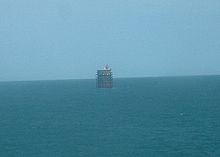- Nab Tower
-
Coordinates: 50°40.05′N 0°57.07′W / 50.6675°N 0.95117°W
The Nab Tower is a tower planned for anti-submarine protection in the Straits of Dover in World War I. It was sunk over the Nab rocks east of the Isle of Wight to replace a lightship after the war, and is a well known landmark for sailors as it marks the deep water eastern entry into the Solent.
Latitude 50° 40'.05 N Longitude 00° 57'.07 W
Height above mean high water 27 metres.
White flash every 10 seconds - 11,739 Candela Incandescent Electric Filament Lamp.
Fog signal - two blasts every 30 seconds (range 2 nautical miles).History
During the First World War the British Admiralty designed eight towers code named M-N that were to be built and positioned in the Straits of Dover to protect allied merchant shipping from German U-boats. Designed by civilian Mr. G. Menzies, the towers were to be linked together with steel nets and armed with two 4-inch guns with the idea of closing the English Channel to enemy ships. However by the end of the war in 1918 only one had been completed, at a fantastic cost (at the time) of one million pounds, and was located at Shoreham Harbour, awaiting deployment. While another part-built tower would eventually be dismantled in 1924, there remained the completed 92-foot-tall (28 m) metal cylinder sitting on a raft of concrete.
In 1920 the completed tower was towed by two paddle wheel tugs to the Nab rock, a rock in the deep-water approach to the eastern Solent and previously marked by a lightship. Buoyancy was provided by the honeycomb construction of the concrete base, creating 18 water-tight compartments. When these were flooded, the structure sank and settled to rest at an angle of 3 degrees from vertical towards the northeast - a characteristic tilt which is obvious to this day.
It was manned as a lighthouse, and during World War II it provided some defence to the Solent approach, and shot down several aircraft. The lighthouse is still functional but since 1983 it has been unmanned.
In November 1999 the Nab was hit by a freighter ship, the Dole-America, carrying a cargo of bananas and pineapples. The ship was badly damaged and only avoided sinking by being run aground. The base of the tower suffered superficial and internal damage. Damage was repaired in 2001.
External links
Categories:- Buildings and structures on the Isle of Wight
- Lighthouses in England
Wikimedia Foundation. 2010.

